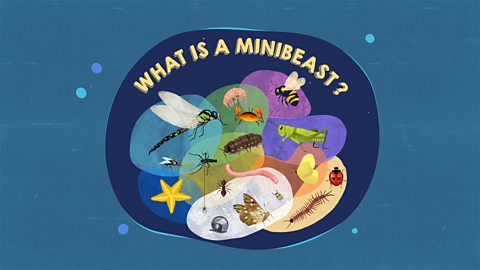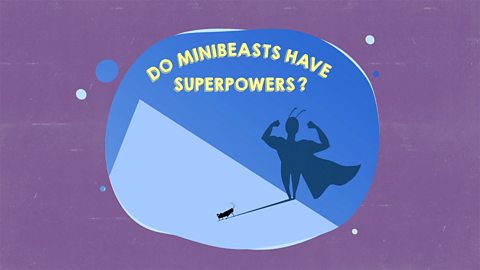Child VO:Where do minibeasts live?
Maddie Moate:Are there any under there? What about over there? Or in thoseplants? Minibeasts are all around us but sometimes they're hardto spot! They're very good at hiding in small spaces and stayingout of sight, even though you might not see them, minibeasts arealways close by! Where do you think minibeasts live?
Connie:Underground?
Jack:In hedges?
Maisie:What about in our homes?
Maddie Moate:Yes, those are all right answers! Minibeasts can live in lots ofdifferent places. We call the homes or environments that they livein 'habitats'.
Maddie Moate:Animals are all uniquely suited to living in their own individualhabitat. Within the UK we have lots of different habitats that suitdifferent minibeasts. These could be grassy fields, rivers andponds, or forests. We also have microhabitats, which are smallerareas such as the roots of a tree where you might find woodliceor slugs. Habitats need to have certain things for animals to livethere happily. They must have a supply of food; water to drink;shelter for rest and enough space to move around freely. Lots ofminibeasts like to live underground, like worms or ants. The soilprovides nutrients for the worms to eat, and ants can buildchambers underground to store food and rest in. Otherminibeasts, like butterflies and grasshoppers, prefer wide openspaces. A field of wildflowers suits these minibeasts as there areplenty of plants and flowers to feed on.
Child VO:What other habitats do minibeasts live in?
Maddie Moate:Some minibeasts build their own home. Bees and wasps live ingroups called colonies and they construct hives and nests to livein and to stay safe. Garden spiders often weave a new web everyday to live on and to catch prey, while woodlouse spiders usetheir silky thread to line their daytime hiding places. And someminibeasts even live right alongside us in our homes. House fliesand house spiders are minibeasts you might see inside yourhouse. The flies look for old food to feed on, while the spiders tryto catch the flies for food. Minibeasts can look very different indifferent parts of the world. You may have seen small spidersaround your home, but spiders like this tarantula with herhandler don't live in the wild in the UK.
Connie:I think she likes to live in a rainforest.
Maddie Moate:Yes, in the wild this type of tarantula lives in the rainforests ofBrazil. They live in burrows, usually near plants that mightattract other smaller insects for them to eat.
Jack:This Giant African Millipede also lives in a rainforest habitat.
Maddie Moate:Millipedes like this one are found in the rainforests of Africa. Allof his legs help him to burrow underground to find a safe place torest.
Maisie:What other minibeasts live in far-away places?
Maddie Moate:The Antarctic midge is the only minibeast that can be found inAntarctica due to the harsh weather conditions. The midge'sbody does not freeze even in the very cold temperatures. This ishow the midge is suited to its habitat. Some minibeasts even livein the sea, like starfish, crabs and sea snails. Like otherminibeasts, crabs are invertebrates, which means they don't havebackbones. Some crabs are suited to their ocean habitat becausethey can breathe underwater, and they have a hard-shellexoskeleton to protect them from predators. Let's hear aboutmore minibeast habitats from our expert!
Yussef:Hi, I'm Yussef, I'm a minibeast expert and these are baby stickinsects. Stick insects are known for their amazing camouflage.These guys come from Australia, they live in trees, and thanks totheir brown spikey look they blend in absolutely perfectly.Minibeasts here in the UK are well suited to their habitats too.Woodlice for example like to live in dark, damp places like underrocks or under tree roots, and they love to eat vegetation anddead plants, and there's plenty of that on the ground where theylive.
Maddie Moate:Can you tell which of these minibeasts is suited to which habitat?
Connie: This stick insect is suited to living in the jungle because it'scamouflaged to blend in with the plants.
Jack:This starfish has loads of little suction cups that can stick ontothe rocks under the water, so it won't get washed away.
Maisie:This moth is the same colour as the tree. It blends in with thebark - it's a great disguise!
Maddie Moate:Yes! All of those minibeasts are suited to their environment,making it the perfect habitat.
Video summary
In this video, a group of children embark on a journey to discover where minibeasts live.
Through exploration and expert insights, children learn about the diverse habitats that support minibeast communities around the world, from underground burrows to lush rainforests and underwater ecosystems.
Teacher notes
Discussion points:
1. Understanding minibeast habitats:
- Define habitats as the environments where animals live and explore the different types of habitats that support minibeast communities.
- Discuss the importance of habitats in providing food, water, shelter, and space for minibeasts to thrive.
- Ask ÔÇô ÔÇÿWhat are habitats, and why are they important for minibeasts?ÔÇÖ
2. UK habitats for minibeasts:
- Explore various habitats found in the UK, such as grassy fields, rivers, ponds, forests, and microhabitats like tree roots.
- Discuss the characteristics of each habitat and the minibeasts that inhabit them.
- Ask ÔÇô ÔÇÿCan you name different habitats where minibeasts live in the UK?ÔÇÖ
3. Global minibeast habitats:
- Introduce children to minibeast habitats in different parts of the world, such as rainforests, deserts, polar regions, and underwater ecosystems.
- Highlight examples of minibeasts adapted to survive in extreme environments.
- Ask ÔÇô ÔÇÿCan you name some different habitats where minibeasts live around the world?ÔÇÖ
4. Minibeast adaptations:
- Discuss some of the physical adaptations that minibeasts have developed to survive in their specific habitats.
- Encourage children to observe and identify adaptations in different minibeasts.
Suggested Activities:
1. Invertebrate habitat maps:
- Provide images of different habitats and ask children to identify and mark areas where minibeasts might live.
2. Minibeast habitat dioramas:
- Invite children to create dioramas showing minibeast habitats using art supplies and natural materials.
3. Minibeast habitat scavenger hunt:
- Organise a scavenger hunt in outdoor spaces where children search for minibeasts and their habitats.
- Provide guidebooks or identification sheets to help children identify minibeasts and learn about their habitats.
4. Cross-curricular science and geography projects:
- Encourage children to research and present information about minibeast habitats in different regions of the world.
Curriculum Notes:
This video supports learning objectives related to science in KS1 within the national curriculums of England and Northern Ireland, and 1st Level in Scotland.
What is a minibeast? video
Learn about the diverse characteristics and habitats of small invertebrates, from slimy snails to speedy spiders.

Do minibeasts have superpowers? video
Children discover how minibeasts use their extraordinary abilities for various purposes, from helping humans to defending themselves against predators.
